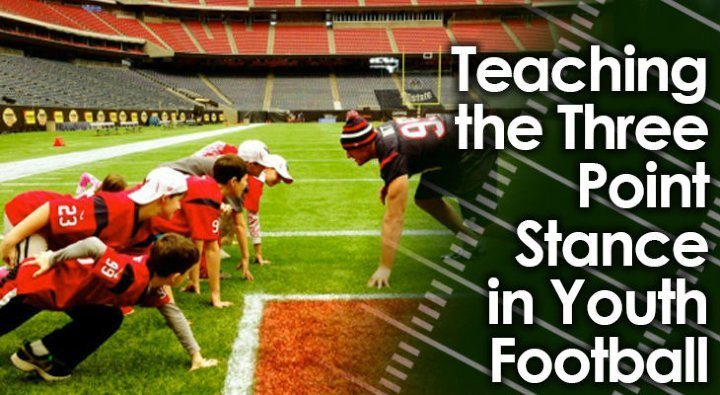Almost all offensive and defensive linemen start every play bent halfway over with their hand touching the ground.
It’s a technique that is done to get these big-bodied players lower to the ground from the start, so that when the ball is snapped, they can remain low and burst through the opposing team’s line.
This is known as the three point stance.
And while it looks very simple to do, it is often executed incorrectly, especially at the youth football level.
Having a stable and proper three point stance is essential if you want to block a defender as an offensive lineman, or burst through and get into the backfield if you’re a defensive lineman.
Coaching youth football is all about explaining something in an easy-to-understand fashion while repeating and reminding your players of the process often.
This goes not only for the three point stance, but for basically every other aspect of the game as well.
Let’s take a more in-depth look at the three point stance, what it is, why it’s so important for linemen, and how to properly teach it in youth football.
What is the Three Point Stance and Why is it Important?
The three point stance is a stance that is used by offensive and defensive linemen and even some running backs in football.
In youth football, in particular, running backs in the backfield and tight ends at the line of scrimmage will also line up in the three point stance.
This stance is often taught on the very first day of football camp.
That’s how important it is...
You can’t move on to teaching offensive or defensive plays or philosophies until your players are able to execute on the basics.
The stance requires players to stand with their feet roughly shoulder-length apart. Their knees will be bent, and they will crouch down.
One hand will be touching the ground with the fingers, while the other hand will bend at the elbow and cross their body at chest height.
The reason why the three point stance is so important is because it helps a player gain leverage on his opponent on any given play.
In fact, the legendary Pop Warner way back in the late 1800s... he figured that if sprinters were able to get a faster start by putting their hands on the ground, then the technique could work for football players as well.

Teaching the Three Point Stance (7 Steps)
1. Width of the Feet
Your feet should be spread out approximately shoulder width apart, but definitely not wider than that.
This will give you good balance.
If your feet are too close or too far away, it will be easy for your opponent to push you off balance.
You can either have both feet parallel to each other or one slightly behind.
2. Direction of the Feet
Once your feet are set at the correct width, point them straight ahead.
This will give you the quickest time off the ground and in the right direction when the ball is snapped.
This is one area where youth football players often have some difficulty.
3. Time to Squat
After your feet are set properly, it’s time to squat down.
Extend one hand down and touch the ground.
It should do so in front of your body, just inside your near foot.
Which hand you place on the ground doesn’t really matter, although most players tend to put the opposite hand down of their dominant hand.
For example, if they’re right-handed, their left hand will be on the ground.
4. Shift Your Weight
About 70 percent of your body weight should be resting on your feet and hips, with the other 30 percent on the down hand.
This will help you maximize the amount of power you are able to use when you explode out of your stance.
5. Position the Off-Hand
Your off-hand that is not on the ground needs to be in a position that is ready to use right away.
If you’re an offensive or defensive lineman, you’ll use this hand early on in the play to either swat away your opponent’s reach, or as part of your blocking/rushing move.
Your arm should rest on your thigh or knee, and your hand should be upright and ready to use.
Your arm should be bent slightly at the elbow and cocked.
6. Square Your Shoulders
Make sure that your shoulders are square to the line of scrimmage while also being parallel to the ground.
Your back should be in a flat position.
7. Use Your Head
Finally, make sure that your head is up.
It’s easy to let your head point down since the rest of your body is pointed down, but this will not only be to your disadvantage technically, but it can be dangerous as well.
By keeping your head up, you will be able to better see the field.
Most importantly, though, keeping your head up will help you avoid injuries from any possible impact with the crown of your helmet.
You need to be able to see what you’re hitting in front of you, and the only way to do that is if your head is up.
Conclusion
The three point stance is the most basic technique that is taught to all offensive and defensive linemen, as well as most running backs in youth football.
It’s something that youth football players need to master on the first day of practice before they can move on to more complicated techniques or learning any formations in the playbook.
The three point stance is something that football players will continue to refine and work on throughout their playing careers.
Even some of the biggest stars in the NFL are constantly working on their football stance to help protect themselves while getting off the ball better.


